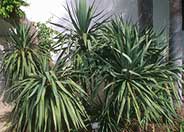
Common name:Orchid or Purple Rockrose
Botanical name:Cistus X purpureus
Orchid rockrose is an evergreen shrub growing to 4' tall and wide, often shorter in stressful situations. The rosy-crimson flowers to 3" wide exhibit a dark purple blotch at the base of each petal, and bloom early to mid-summer. The flowers also feature a contrasting yellow cluster of stamens in the center. It does well in salt spray and cool winds. It is relatively long-lived, tolerant of heat and aridity as well as accepting many soil conditions.

Common name:Century Plant, Maguey
Botanical name:Agave americana
This plant is fast growing to about 6'-10' tall and 8'-13' wide. Wide gray leaves have stiff terminal spines and recurved teeth on margins. It prefers full sun and well-drained situations. After blooming, which could take several years, it will die but will send up new pups from around the base. Some people are allergic to the sap. Removal is difficult if unwanted.

Common name:Eulalia Grass
Botanical name:Miscanthus sinensis
Miscanthus sinensis is popular ornamental grass. Flowers are held well above foliage clumps and may be cut for fresh or dry arrangements.

Common name:Coast Live Oak
Botanical name:Quercus agrifolia
Coast Live Oak (Quercus agrifolia) is one of the best trees for California native or California-friendly gardens. It grows very well from the coastal areas to the interior valleys. It is an evergreen tree that can reach 25’-70' tall and up to 70' wide, so make sure you have the space in your garden to support it. It is considered very low-water-use and is susceptible to root rot in gardens that are over-irrigated. Plant it with other California natives or low-water plants and stick to a watering cycle that includes watering during the fall, winter, and spring with no supplemental water in the summer. The tree is a slow grower and has an irregular shape when it is young, so it is important to make minimal pruning cuts to improve the look of the canopy. Over-pruning or hedging can take years to recover from, so consult or hire a licensed arborist when the shaping becomes out of your reach. This tree will eventually become a large shade tree; therefore, the plant selection around it may need to be adjusted as it matures. This tree should be planted at least five feet away from any hardscape areas, 20 feet from structures such as houses and buildings, and not near any powerlines. Shrubs and perennials should be planted about four feet away from this tree. It should be irrigated for about 45 minutes once a week when using most in-line drip irrigation systems.

Common name:Aloe Vera or Medicinal Aloe
Botanical name:Aloe vera
The rosette of this plant consists of fleshy gray green leaves, which are narrow, succulent and erect with soft spines on margins. This Aloe is a slow to moderate grower. Flowers are spikes of yellow, 2'-3' tall and bloom late winter to summer. This aloe can form large clumps. It will tolerate full to partial sun, needs some supplemental water in heat and good drainage. It attracts hummingbirds. This aloe is a Mediterranean native. The sap is used for burns and abrasions.

Common name:Spineless Yucca
Botanical name:Yucca recurvifolia
This evergreen shrub is part of the Agave family and reaches 6'-10' tall. It has distinctive blue gray leaves that bend sharply downward. It blooms with white flowers on 3'-5' tall spikes in late spring and early summer. Leaf tips have spines but they bend and do not cause injury.
Designer: N/A
Photographer: GardenSoft
Maintain a two to four inch layer of mulch on the soil surface to reduce weeds, infiltrate rain water, and reduce compaction.
Develop healthy soil for plants that are vigorous and naturally pest-resistant.